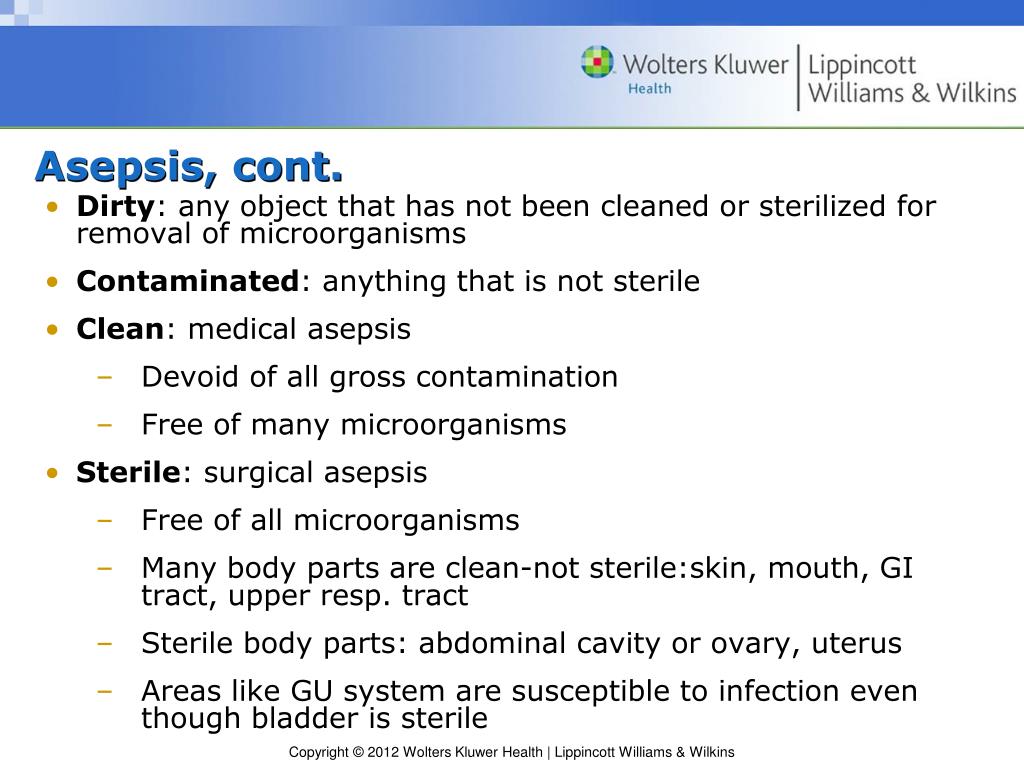

#DEFINE SURGICAL ASEPSIS HOW TO#
When performing a procedure, ensure the patient understands how to prevent contamination of equipment and knows to refrain from sudden movements or touching, laughing, sneezing, or talking over the sterile field.Hand hygiene is a priority before any aseptic procedure.Checklist 9: Principles of Sterile Technique Disclaimer: Always review and follow your hospital policy regarding this specific skill. See Checklist 9 for the principles of sterile technique. It is the responsibility of all health care workers to speak up and protect all patients from infection. These principles must be strictly applied when performing any aseptic procedures, when assisting with aseptic procedures, and when intervening when the principles of surgical asepsis are breached. Principles of Surgical AsepsisĪll personnel involved in an aseptic procedure are required to follow the principles and practice set forth by the Association of periOperative Registered Nurses (AORN). Preventing and reducing SSI are the most important reasons for using sterile technique during invasive procedures and surgeries. Sterile technique is essential to help prevent surgical site infections (SSI), an unintended and oftentimes preventable complication arising from surgery. SSI is defined as an “infection that occurs after surgery in the area of surgery” (CDC, 2010, p. Sterile technique may include the use of sterile equipment, sterile gowns, and gloves (Perry et al., 2014).
#DEFINE SURGICAL ASEPSIS SKIN#
In health care, sterile technique is always used when the integrity of the skin is accessed, impaired, or broken (e.g., burns or surgical incisions). It is also used when performing a sterile procedure at the bedside, such as inserting devices into sterile areas of the body or cavities (e.g., insertion of chest tube, central venous line, or indwelling urinary catheter). Sterile technique is most commonly practised in operating rooms, labour and delivery rooms, and special procedures or diagnostic areas. Principles of sterile technique help control and prevent infection, prevent the transmission of all microorganisms in a given area, and include all techniques that are practised to maintain sterility. In the literature, surgical asepsis and sterile technique are commonly used interchangeably, but they mean different things (Kennedy, 2013).
#DEFINE SURGICAL ASEPSIS FREE#
Sterile technique is a set of specific practices and procedures performed to make equipment and areas free from all microorganisms and to maintain that sterility (BC Centre for Disease Control, 2010).

Surgical asepsis is the absence of all microorganisms within any type of invasive procedure.

Medical asepsis includes the methods used in a general medical setting to reduce the spread of microbes and eliminate such contaminants. What is the Difference Between Medical and Surgical Asepsis. › Memorial Regional Hospital Medical Recordsįrequently Asked Questions What is the difference between medical and surgical asepsis?.› The Nature Fix Why Nature Makes Us Happier Healthier And More Creative.› Chesapeake Health Care Patient Portal.› West Virginia Behavioral Health Conference.› Good Bad Ugly Hiring Career Coach Kathy Caprino.› Does Metropolitan Life Insurance Company Still Exist.› Regionalcare Hospital Partners To Merge With Essent Healthcare.



 0 kommentar(er)
0 kommentar(er)
